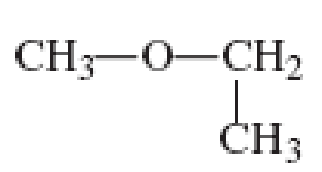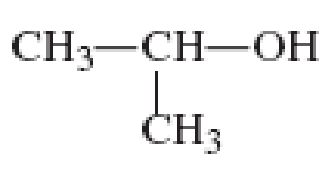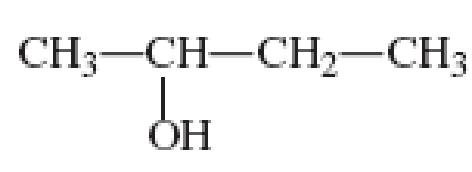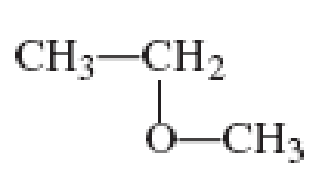
Organic And Biological Chemistry
7th Edition
ISBN: 9781305081079
Author: STOKER, H. Stephen (howard Stephen)
Publisher: Cengage Learning,
expand_more
expand_more
format_list_bulleted
Textbook Question
Chapter 3, Problem 3.91EP
Classify each of the following compounds as an ether, an alcohol, or neither an ether or alcohol.




Expert Solution & Answer
Want to see the full answer?
Check out a sample textbook solution
Students have asked these similar questions
Draw the formula of the product obtained by reacting adipic acid 1st with PCl5 and 2nd treatment with NH3.
please help me with my homework
help
Chapter 3 Solutions
Organic And Biological Chemistry
Ch. 3.1 - Prob. 1QQCh. 3.1 - Prob. 2QQCh. 3.2 - Prob. 1QQCh. 3.2 - Prob. 2QQCh. 3.2 - Prob. 3QQCh. 3.3 - Prob. 1QQCh. 3.3 - Prob. 2QQCh. 3.3 - Prob. 3QQCh. 3.3 - Prob. 4QQCh. 3.4 - Prob. 1QQ
Ch. 3.4 - Prob. 2QQCh. 3.4 - Prob. 3QQCh. 3.5 - Prob. 1QQCh. 3.5 - Prob. 2QQCh. 3.5 - Prob. 3QQCh. 3.5 - Prob. 4QQCh. 3.6 - Prob. 1QQCh. 3.6 - Prob. 2QQCh. 3.6 - Prob. 3QQCh. 3.7 - Prob. 1QQCh. 3.7 - Prob. 2QQCh. 3.8 - Prob. 1QQCh. 3.8 - Prob. 2QQCh. 3.9 - Prob. 1QQCh. 3.9 - Prob. 2QQCh. 3.9 - Prob. 3QQCh. 3.9 - Prob. 4QQCh. 3.9 - Prob. 5QQCh. 3.9 - Prob. 6QQCh. 3.10 - Prob. 1QQCh. 3.10 - Prob. 2QQCh. 3.11 - Prob. 1QQCh. 3.11 - Prob. 2QQCh. 3.11 - Prob. 3QQCh. 3.12 - Prob. 1QQCh. 3.12 - Prob. 2QQCh. 3.13 - Prob. 1QQCh. 3.13 - Prob. 2QQCh. 3.13 - Prob. 3QQCh. 3.14 - Prob. 1QQCh. 3.14 - Prob. 2QQCh. 3.14 - Prob. 3QQCh. 3.15 - Prob. 1QQCh. 3.15 - Prob. 2QQCh. 3.15 - Prob. 3QQCh. 3.15 - Prob. 4QQCh. 3.16 - Prob. 1QQCh. 3.16 - Prob. 2QQCh. 3.17 - Prob. 1QQCh. 3.17 - Prob. 2QQCh. 3.17 - Prob. 3QQCh. 3.18 - Prob. 1QQCh. 3.18 - Prob. 2QQCh. 3.18 - Prob. 3QQCh. 3.19 - Prob. 1QQCh. 3.19 - Prob. 2QQCh. 3.20 - Prob. 1QQCh. 3.20 - Prob. 2QQCh. 3.20 - Prob. 3QQCh. 3.20 - Prob. 4QQCh. 3.20 - Prob. 5QQCh. 3.21 - Prob. 1QQCh. 3.21 - Prob. 2QQCh. 3.21 - Prob. 3QQCh. 3.21 - Prob. 4QQCh. 3.21 - Prob. 5QQCh. 3 - Prob. 3.1EPCh. 3 - Indicate whether or not each of the following...Ch. 3 - Prob. 3.3EPCh. 3 - Prob. 3.4EPCh. 3 - Prob. 3.5EPCh. 3 - Prob. 3.6EPCh. 3 - Prob. 3.7EPCh. 3 - Prob. 3.8EPCh. 3 - Prob. 3.9EPCh. 3 - Prob. 3.10EPCh. 3 - Write a condensed structural formula for each of...Ch. 3 - Write a condensed structural formula for each of...Ch. 3 - Prob. 3.13EPCh. 3 - Prob. 3.14EPCh. 3 - Prob. 3.15EPCh. 3 - Prob. 3.16EPCh. 3 - Prob. 3.17EPCh. 3 - Prob. 3.18EPCh. 3 - Prob. 3.19EPCh. 3 - Prob. 3.20EPCh. 3 - Prob. 3.21EPCh. 3 - Prob. 3.22EPCh. 3 - Prob. 3.23EPCh. 3 - Prob. 3.24EPCh. 3 - Prob. 3.25EPCh. 3 - Prob. 3.26EPCh. 3 - Prob. 3.27EPCh. 3 - Prob. 3.28EPCh. 3 - Prob. 3.29EPCh. 3 - Prob. 3.30EPCh. 3 - Give the IUPAC name of the alcohol that fits each...Ch. 3 - Prob. 3.32EPCh. 3 - Prob. 3.33EPCh. 3 - Prob. 3.34EPCh. 3 - Prob. 3.35EPCh. 3 - Prob. 3.36EPCh. 3 - Prob. 3.37EPCh. 3 - Which member of each of the following pairs of...Ch. 3 - Prob. 3.39EPCh. 3 - Which member of each of the following pairs of...Ch. 3 - Determine the maximum number of hydrogen bonds...Ch. 3 - Prob. 3.42EPCh. 3 - Prob. 3.43EPCh. 3 - Prob. 3.44EPCh. 3 - Prob. 3.45EPCh. 3 - Prob. 3.46EPCh. 3 - Classify each of the following alcohols as a...Ch. 3 - Classify each of the following alcohols as a...Ch. 3 - Classify each of the following alcohols as a...Ch. 3 - Classify each of the following alcohols as a...Ch. 3 - Prob. 3.51EPCh. 3 - Prob. 3.52EPCh. 3 - Prob. 3.53EPCh. 3 - Prob. 3.54EPCh. 3 - Prob. 3.55EPCh. 3 - Prob. 3.56EPCh. 3 - Prob. 3.57EPCh. 3 - Prob. 3.58EPCh. 3 - Prob. 3.59EPCh. 3 - Prob. 3.60EPCh. 3 - The alcohol 2,2-dimethyl-1-butanol cannot be...Ch. 3 - Prob. 3.62EPCh. 3 - Prob. 3.63EPCh. 3 - Prob. 3.64EPCh. 3 - Prob. 3.65EPCh. 3 - Prob. 3.66EPCh. 3 - Prob. 3.67EPCh. 3 - Prob. 3.68EPCh. 3 - Prob. 3.69EPCh. 3 - Prob. 3.70EPCh. 3 - Prob. 3.71EPCh. 3 - Prob. 3.72EPCh. 3 - Prob. 3.73EPCh. 3 - Prob. 3.74EPCh. 3 - Prob. 3.75EPCh. 3 - Prob. 3.76EPCh. 3 - Prob. 3.77EPCh. 3 - Prob. 3.78EPCh. 3 - Prob. 3.79EPCh. 3 - Prob. 3.80EPCh. 3 - Prob. 3.81EPCh. 3 - Prob. 3.82EPCh. 3 - Prob. 3.83EPCh. 3 - Prob. 3.84EPCh. 3 - Prob. 3.85EPCh. 3 - Prob. 3.86EPCh. 3 - Prob. 3.87EPCh. 3 - Prob. 3.88EPCh. 3 - Prob. 3.89EPCh. 3 - Prob. 3.90EPCh. 3 - Classify each of the following compounds as an...Ch. 3 - Prob. 3.92EPCh. 3 - Draw or write the following for the simplest ether...Ch. 3 - Draw or write the following for the simplest ether...Ch. 3 - Prob. 3.95EPCh. 3 - Prob. 3.96EPCh. 3 - Assign a common name to each of the ethers in...Ch. 3 - Prob. 3.98EPCh. 3 - Prob. 3.99EPCh. 3 - Prob. 3.100EPCh. 3 - Prob. 3.101EPCh. 3 - Prob. 3.102EPCh. 3 - Prob. 3.103EPCh. 3 - Prob. 3.104EPCh. 3 - Prob. 3.105EPCh. 3 - Prob. 3.106EPCh. 3 - Prob. 3.107EPCh. 3 - Prob. 3.108EPCh. 3 - Prob. 3.109EPCh. 3 - Prob. 3.110EPCh. 3 - Prob. 3.111EPCh. 3 - Prob. 3.112EPCh. 3 - Prob. 3.113EPCh. 3 - Prob. 3.114EPCh. 3 - How many isomeric ethers exist when the R groups...Ch. 3 - Prob. 3.116EPCh. 3 - Prob. 3.117EPCh. 3 - Prob. 3.118EPCh. 3 - Prob. 3.119EPCh. 3 - Prob. 3.120EPCh. 3 - Dimethyl ether and ethanol have the same molecular...Ch. 3 - Prob. 3.122EPCh. 3 - Prob. 3.123EPCh. 3 - Prob. 3.124EPCh. 3 - Prob. 3.125EPCh. 3 - Prob. 3.126EPCh. 3 - Classify each of the following molecular...Ch. 3 - Classify each of the following molecular...Ch. 3 - Prob. 3.129EPCh. 3 - Prob. 3.130EPCh. 3 - Prob. 3.131EPCh. 3 - Draw a condensed structural formula for each of...Ch. 3 - Prob. 3.133EPCh. 3 - Prob. 3.134EPCh. 3 - Prob. 3.135EPCh. 3 - Write the formulas for the sulfur-containing...Ch. 3 - Prob. 3.137EPCh. 3 - For each of the following pairs of compounds,...Ch. 3 - Prob. 3.139EPCh. 3 - Prob. 3.140EPCh. 3 - Prob. 3.141EPCh. 3 - Prob. 3.142EPCh. 3 - Prob. 3.143EPCh. 3 - Prob. 3.144EPCh. 3 - Prob. 3.145EPCh. 3 - Prob. 3.146EP
Knowledge Booster
Learn more about
Need a deep-dive on the concept behind this application? Look no further. Learn more about this topic, chemistry and related others by exploring similar questions and additional content below.Similar questions
- The temperature on a sample of pure X held at 1.25 atm and -54. °C is increased until the sample boils. The temperature is then held constant and the pressure is decreased by 0.42 atm. On the phase diagram below draw a path that shows this set of changes. pressure (atm) 2 0 0 200 400 temperature (K) Xarrow_forwardQUESTION: Answer Question 5: 'Calculating standard error of regression' STEP 1 by filling in all the empty green boxes *The values are all provided in the photo attached*arrow_forwardpressure (atm) 3 The pressure on a sample of pure X held at 47. °C and 0.88 atm is increased until the sample condenses. The pressure is then held constant and the temperature is decreased by 82. °C. On the phase diagram below draw a path that shows this set of changes. 0 0 200 temperature (K) 400 аarrow_forward
- er your payment details | bar xb Home | bartleby x + aleksogi/x/isl.exe/1o u-lgNskr7j8P3jH-1Qs_pBanHhviTCeeBZbufuBYT0Hz7m7D3ZcW81NC1d8Kzb4srFik1OUFhKMUXzhGpw7k1 O States of Matter Sketching a described thermodynamic change on a phase diagram 0/5 The pressure on a sample of pure X held at 47. °C and 0.88 atm is increased until the sample condenses. The pressure is then held constant and the temperature is decreased by 82. °C. On the phase diagram below draw a path that shows this set of changes. pressure (atm) 1 3- 0- 0 200 Explanation Check temperature (K) 400 X Q Search L G 2025 McGraw Hill LLC. All Rights Reserved Terms of Use Privacy Cearrow_forward5.arrow_forward6.arrow_forward
- 0/5 alekscgi/x/sl.exe/1o_u-IgNglkr7j8P3jH-IQs_pBaHhvlTCeeBZbufuBYTi0Hz7m7D3ZcSLEFovsXaorzoFtUs | AbtAURtkqzol 1HRAS286, O States of Matter Sketching a described thermodynamic change on a phase diagram The pressure on a sample of pure X held at 47. °C and 0.88 atm is increased until the sample condenses. The pressure is then held constant and the temperature is decreased by 82. °C. On the phase diagram below draw a path that shows this set of changes. 3 pressure (atm) + 0- 0 5+ 200 temperature (K) 400 Explanation Check X 0+ F3 F4 F5 F6 F7 S 2025 McGraw Hill LLC All Rights Reserved. Terms of Use Privacy Center Accessibility Q Search LUCR + F8 F9 F10 F11 F12 * % & ( 5 6 7 8 9 Y'S Dele Insert PrtSc + Backsarrow_forward5.arrow_forward9arrow_forward
- alekscgi/x/lsl.exe/1o_u-IgNslkr7j8P3jH-IQs_pBanHhvlTCeeBZbufu BYTI0Hz7m7D3ZS18w-nDB10538ZsAtmorZoFusYj2Xu9b78gZo- O States of Matter Sketching a described thermodynamic change on a phase diagram 0/5 The pressure on a sample of pure X held at 47. °C and 0.88 atm is increased until the sample condenses. The pressure is then held constant and the temperature is decreased by 82. °C. On the phase diagram below draw a path that shows this set of changes. pressure (atm) 3- 200 temperature (K) Explanation Chick Q Sowncharrow_forward0+ aleksog/x/lsl.exe/1ou-lgNgkr7j8P3H-IQs pBaHhviTCeeBZbufuBYTOHz7m7D3ZStEPTBSB3u9bsp3Da pl19qomOXLhvWbH9wmXW5zm O States of Matter Sketching a described thermodynamic change on a phase diagram 0/5 Gab The temperature on a sample of pure X held at 0.75 atm and -229. °C is increased until the sample sublimes. The temperature is then held constant and the pressure is decreased by 0.50 atm. On the phase diagram below draw a path that shows this set of changes. F3 pressure (atm) 0- 0 200 Explanation temperature (K) Check F4 F5 ☀+ Q Search Chill Will an 9 ENG F6 F7 F8 F9 8 Delete F10 F11 F12 Insert PrtSc 114 d Ararrow_forwardx + LEKS: Using a phase diagram a X n/alekscgi/x/lsl.exe/10_u-IgNsikr7j8P3jH-IQs_pBan HhvlTCeeBZbufu BYTI0Hz7m7D3ZcHYUt80XL-5alyVpw ○ States of Matter Using a phase diagram to find a phase transition temperature or pressure Use the phase diagram of Substance X below to find the melting point of X when the pressure above the solid is 1.1 atm. pressure (atm) 16 08- solid liquid- 0 200 400 gas 600 temperature (K) Note: your answer must be within 25 °C of the exact answer to be graded correct. × 5arrow_forward
arrow_back_ios
SEE MORE QUESTIONS
arrow_forward_ios
Recommended textbooks for you
 Organic And Biological ChemistryChemistryISBN:9781305081079Author:STOKER, H. Stephen (howard Stephen)Publisher:Cengage Learning,
Organic And Biological ChemistryChemistryISBN:9781305081079Author:STOKER, H. Stephen (howard Stephen)Publisher:Cengage Learning, General, Organic, and Biological ChemistryChemistryISBN:9781285853918Author:H. Stephen StokerPublisher:Cengage Learning
General, Organic, and Biological ChemistryChemistryISBN:9781285853918Author:H. Stephen StokerPublisher:Cengage Learning Introductory Chemistry: An Active Learning Approa...ChemistryISBN:9781305079250Author:Mark S. Cracolice, Ed PetersPublisher:Cengage Learning
Introductory Chemistry: An Active Learning Approa...ChemistryISBN:9781305079250Author:Mark S. Cracolice, Ed PetersPublisher:Cengage Learning Chemistry for Today: General, Organic, and Bioche...ChemistryISBN:9781305960060Author:Spencer L. Seager, Michael R. Slabaugh, Maren S. HansenPublisher:Cengage Learning
Chemistry for Today: General, Organic, and Bioche...ChemistryISBN:9781305960060Author:Spencer L. Seager, Michael R. Slabaugh, Maren S. HansenPublisher:Cengage Learning Chemistry & Chemical ReactivityChemistryISBN:9781133949640Author:John C. Kotz, Paul M. Treichel, John Townsend, David TreichelPublisher:Cengage Learning
Chemistry & Chemical ReactivityChemistryISBN:9781133949640Author:John C. Kotz, Paul M. Treichel, John Townsend, David TreichelPublisher:Cengage Learning World of Chemistry, 3rd editionChemistryISBN:9781133109655Author:Steven S. Zumdahl, Susan L. Zumdahl, Donald J. DeCostePublisher:Brooks / Cole / Cengage Learning
World of Chemistry, 3rd editionChemistryISBN:9781133109655Author:Steven S. Zumdahl, Susan L. Zumdahl, Donald J. DeCostePublisher:Brooks / Cole / Cengage Learning

Organic And Biological Chemistry
Chemistry
ISBN:9781305081079
Author:STOKER, H. Stephen (howard Stephen)
Publisher:Cengage Learning,

General, Organic, and Biological Chemistry
Chemistry
ISBN:9781285853918
Author:H. Stephen Stoker
Publisher:Cengage Learning

Introductory Chemistry: An Active Learning Approa...
Chemistry
ISBN:9781305079250
Author:Mark S. Cracolice, Ed Peters
Publisher:Cengage Learning

Chemistry for Today: General, Organic, and Bioche...
Chemistry
ISBN:9781305960060
Author:Spencer L. Seager, Michael R. Slabaugh, Maren S. Hansen
Publisher:Cengage Learning

Chemistry & Chemical Reactivity
Chemistry
ISBN:9781133949640
Author:John C. Kotz, Paul M. Treichel, John Townsend, David Treichel
Publisher:Cengage Learning

World of Chemistry, 3rd edition
Chemistry
ISBN:9781133109655
Author:Steven S. Zumdahl, Susan L. Zumdahl, Donald J. DeCoste
Publisher:Brooks / Cole / Cengage Learning
07 Physical Properties of Organic Compounds; Author: Mindset;https://www.youtube.com/watch?v=UjlSgwq4w6U;License: Standard YouTube License, CC-BY